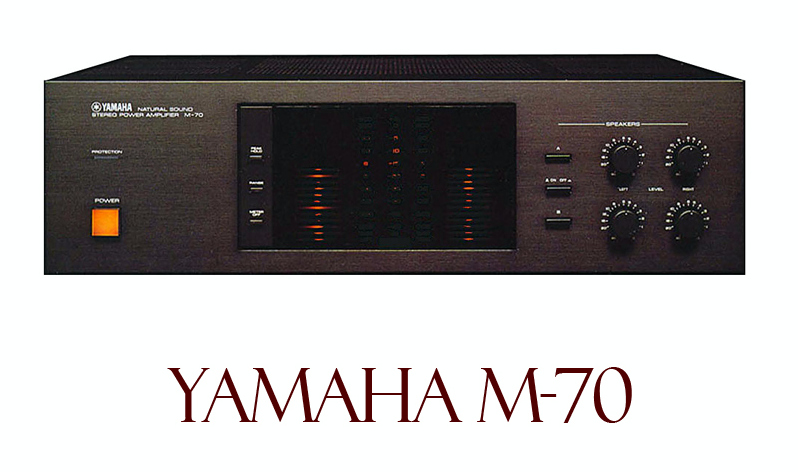Difference between revisions of "Yamaha M-70"
| (12 intermediate revisions by 11 users not shown) | |||
| Line 1: | Line 1: | ||
__NOTOC__ | __NOTOC__ | ||
| − | == | + | == Data == |
| − | {{ | + | {{navigation}} |
| − | ''' | + | '''General''' |
| − | * | + | * Manufacturer: [[Yamaha]] |
| − | * | + | * Model: M-70 |
| − | * | + | * Type: Power amplifier |
| − | * | + | * Years of manufacture: 1982 - 1984 |
| − | * | + | * Color: Black |
| − | * | + | * Remote control: No |
| − | * | + | * Power consumption: 900 W |
| − | * | + | * Dimensions: 435 x 133 x 380 mm (WxHxD) |
| − | * | + | * Weight: 15,7 kg |
| − | + | * Original price approx.: 2'200 DM | |
| − | ''' | + | '''Connections''' |
| − | * | + | * Number of inputs: |
** Line | ** Line | ||
| − | * | + | * Number of outputs: |
| − | ** 2x | + | ** 2x loudspeaker |
| − | ''' | + | '''Technical Data''' |
| − | * | + | * Continuous power (at distortion factor) |
** 8 Ohm: 2x 200 Watt | ** 8 Ohm: 2x 200 Watt | ||
| − | + | 4 Ohm: 2x 250 Watt (M-70 cannot be measured at 4 Ohm!) | |
| − | * | + | * Dynamic power |
** 8 Ohm: | ** 8 Ohm: | ||
** 4 Ohm: | ** 4 Ohm: | ||
| − | * | + | * Total harmonic distortion: 0.002% |
| − | * | + | * Attenuation factor: 200 |
| − | * | + | * Input (Sensitivity/Impedance) |
| − | ** Line 1 | + | ** Line 1.41V/25 KOhm |
| − | * | + | * Frequency response: 0-100000 Hz |
| − | * | + | * Ripple distance (shorted): |
| − | * | + | * Stereo channel separation: 95dB |
| − | * | + | * Signal to noise ratio: 124dB |
| − | ''' | + | '''Special Features''' |
| − | * | + | * Power meter, switchable and sensitivity switchable |
| − | * | + | * Channel-separated level controls for speaker pairs |
| − | == | + | == Remarks == |
| − | + | * Other models in the same series: | |
| − | * [[Yamaha M-50 | + | * [[Yamaha M-50]] |
| + | * [[Yamaha M-70]] | ||
| + | * [[Yamaha BX-1]] | ||
| − | |||
| − | |||
| − | + | * [[Yamaha M-2]] | |
| − | * [[Yamaha M- | + | * [[Yamaha M-2]] |
| − | |||
| − | == | + | * Successor model: |
| + | * [[Yamaha M-80]] | ||
| + | |||
| + | |||
| + | == Pictures == | ||
| + | * Image: Yamaha M-70 | ||
| + | [[File:Yamaha M-70-1.jpg]] | ||
| + | |||
| + | |||
| + | == Reviews == | ||
| + | * The M-70 was offered as a pure 8 Ohm power amplifier (which you should follow!), but it also runs at high volumes (>200W) without any problems at 4 Ohm. | ||
| + | |||
== Links == | == Links == | ||
| + | * [http://www.mackern.de/index.php/2009/10/13/yamaha-m-70/ Mackern.de - Read Hifi Yamaha M-70] | ||
| + | |||
| − | [[ | + | [[Category:Power Amplifiers]] |
Latest revision as of 05:04, 22 October 2019
Data
General
- Manufacturer: Yamaha
- Model: M-70
- Type: Power amplifier
- Years of manufacture: 1982 - 1984
- Color: Black
- Remote control: No
- Power consumption: 900 W
- Dimensions: 435 x 133 x 380 mm (WxHxD)
- Weight: 15,7 kg
- Original price approx.: 2'200 DM
Connections
- Number of inputs:
- Line
- Number of outputs:
- 2x loudspeaker
Technical Data
- Continuous power (at distortion factor)
- 8 Ohm: 2x 200 Watt
4 Ohm: 2x 250 Watt (M-70 cannot be measured at 4 Ohm!)
- Dynamic power
- 8 Ohm:
- 4 Ohm:
- Total harmonic distortion: 0.002%
- Attenuation factor: 200
- Input (Sensitivity/Impedance)
- Line 1.41V/25 KOhm
- Frequency response: 0-100000 Hz
- Ripple distance (shorted):
- Stereo channel separation: 95dB
- Signal to noise ratio: 124dB
Special Features
- Power meter, switchable and sensitivity switchable
- Channel-separated level controls for speaker pairs
Remarks
- Other models in the same series:
- Yamaha M-50
- Yamaha M-70
- Yamaha BX-1
- Successor model:
- Yamaha M-80
Pictures
- Image: Yamaha M-70
Reviews
- The M-70 was offered as a pure 8 Ohm power amplifier (which you should follow!), but it also runs at high volumes (>200W) without any problems at 4 Ohm.
